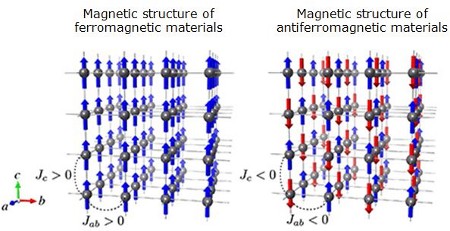Discovery of a Method for Maximizing the Magnetic Refrigeration efficiency of Antiferromagnetic Materials
2014.03.10
(2014.04.01 Update)
National Institute for Materials Science (NIMS)
Dr. Ryo Tamura, ICYS-Sengen researcher of the NIMS International Center for Young Scientists (ICYS), Dr. Takahisa Ohno, Director of the Computational Materials Science Unit of the Advanced Key Technologies Division, and Dr. Hideaki Kitazawa, Director of the Quantum Beam Unit of the same division discovered a method for maximizing the magnetic refrigeration efficiencies of antiferromagnetic materials by computer simulation.
Abstract
- Dr. Ryo Tamura, ICYS-Sengen researcher of the International Center for Young Scientists (ICYS; Managing Director: Kenjiro Miyano) of NIMS (President: Sukekatsu Ushioda), Dr. Takahisa Ohno, Director of the Computational Materials Science Unit of the Advanced Key Technologies Division, and Dr. Hideaki Kitazawa, Director of the Quantum Beam Unit of the same division discovered a method for maximizing the magnetic refrigeration efficiencies of antiferromagnetic materials by computer simulation.
- Magnetic refrigeration is a cooling technology which utilizes the magnetocaloric effect of magnetic materials. It is being developed as a candidate next-generation cooling technology to replace gas refrigeration. In order to achieve a wide range of practical uses for magnetic refrigeration, it is absolutely necessary to develop novel magnetic materials with higher magnetic refrigeration efficiencies as well as methods of enhancing the magnetic refrigeration efficiencies of existing materials.
- Using super computers in NIMS and the Institute for Solid State Physics, University of Tokyo, the researchers obtained the magnetocaloric effects exhibited by ferromagnetic materials and antiferromagnetic materials with high accuracy. As a result, they confirmed that changing a magnetic field from a finite magnetic field to a zero field maximizes the magnetic refrigeration efficiency of ferromagnetic materials. At the same time, it became clear that since antiferromagnetic materials exhibit magnetocaloric effects different from those of ferromagnetic materials, the conventional procedure for applying a magnetic field only achieves low level magnetic refrigeration efficiencies. The researchers finally discovered that in order to maximize the magnetic refrigeration efficiencies of antiferromagnetic materials, it is necessary to avoid changing the magnetic field to a zero field and stop the change at a certain finite magnetic field level, depending on the target temperature.
- The procedure discovered by the researchers is not designed only for antiferromagnetic materials, but will be widely applicable to materials that exhibit non-ferromagnetic structures. The application of this procedure will make it possible to compare and maximize the magnetic refrigeration efficiencies of all kinds of magnetic materials. It is therefore expected to expand the potential for the development of magnetic materials suitable for magnetic refrigeration.
- The research results will be published in Applied Physics Letters, a publication of the American Institute of Physics.

Figure 1: (left) schematic of the magnetic structure of ferromagnetic materials; (right) schematic of the magnetic structure of antiferromagnetic materials. The blue arrows represent the upward electronic spin state and the red arrows represent the downward electronic spin state. Jab and Jc denote the exchange interactions between magnetic ions.